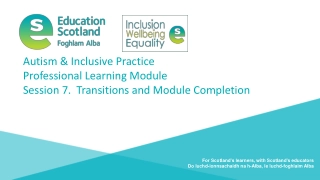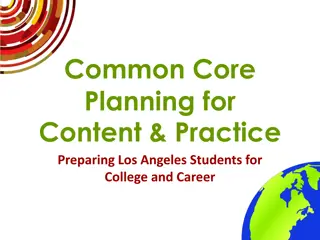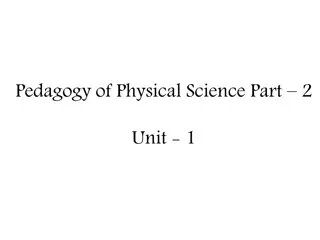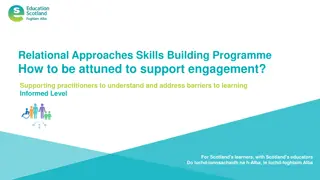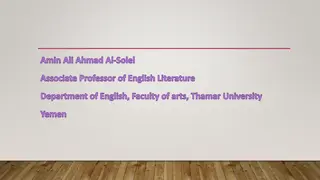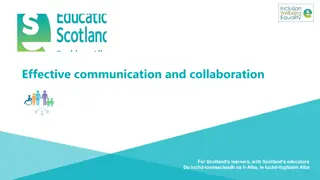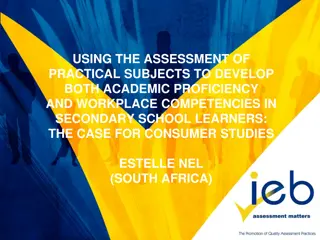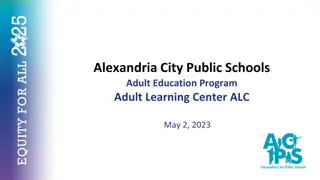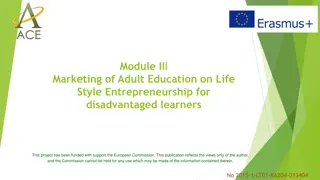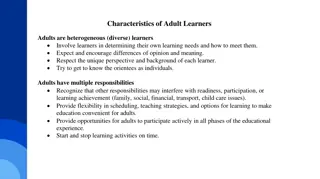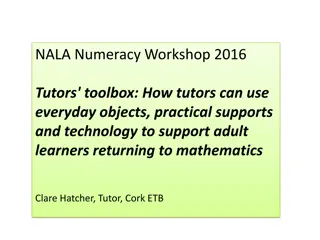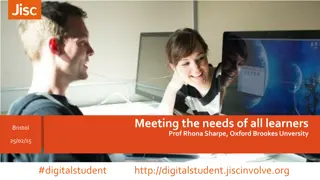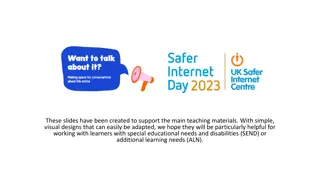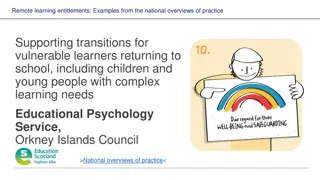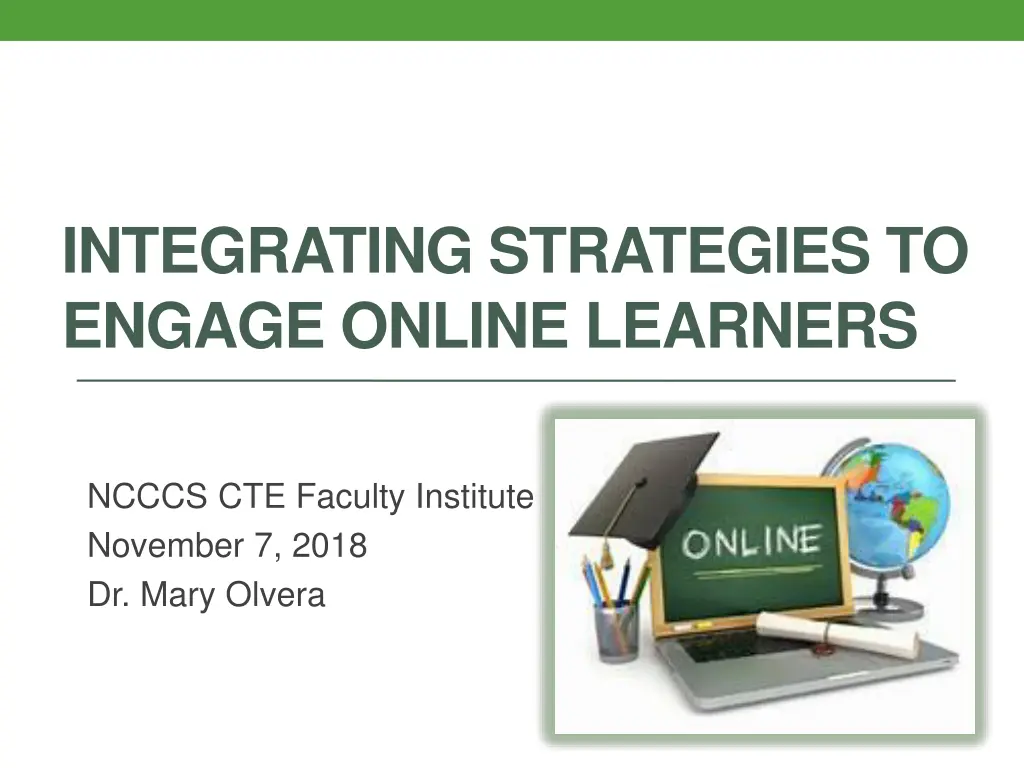
Strategies for Engaging Online and Adult Learners Effectively
Learn how to enhance online engagement and optimize learning outcomes for both adult and adolescent learners through effective strategies and foundational concepts. Discover the importance of relationship-building, relevance, and responsibility in engaging adult learners, as well as the key components of emotional spark, social engagement, novelty, and creative expressions in engaging adolescent learners.
Download Presentation

Please find below an Image/Link to download the presentation.
The content on the website is provided AS IS for your information and personal use only. It may not be sold, licensed, or shared on other websites without obtaining consent from the author. If you encounter any issues during the download, it is possible that the publisher has removed the file from their server.
You are allowed to download the files provided on this website for personal or commercial use, subject to the condition that they are used lawfully. All files are the property of their respective owners.
The content on the website is provided AS IS for your information and personal use only. It may not be sold, licensed, or shared on other websites without obtaining consent from the author.
E N D
Presentation Transcript
INTEGRATING STRATEGIES TO ENGAGE ONLINE LEARNERS NCCCS CTE Faculty Institute November 7, 2018 Dr. Mary Olvera
First. Define online engagement.
What We Know Online growth has outpaced total growth since 2003 (Brewer & Brewer, 2015). Web-Assisted Hybrid Synchronous Online Asynchronous Online "relationship resiliency appears to be an important resilience to address at all grade levels" (Taylor & Karcher, 2009, p. 8).
Engaging Students Learning is optimized when students are actively engaged in learning. Research on teaching and learning shows that most of us remember: 10% of what we read 20% of what we hear 30% of what we see 50% of what we both see and hear 70% of what we have discussed with others 80% of what we have experienced personally 95% of what we teach someone else
Foundational Concepts for Online Learning Online instruction is not replicating in-class instruction; it is about offering an effective learning experience. Online courses can be produced very well or very poorly. Development of courses should be guided by the context of the course, the program, the students, the technology, and the faculty. Thorough planning and a rich mixture of technology enable effective learning. Social communication is important. It is critical to address student, faculty, and administrative motivators in order to provide programs of excellence (Brewer & Brewer, 2015)
Adult Learners Adult learners are stimulated by authentic, meaningful learning experiences that allow for the application of knowledge and skills to real life situations. Adult learners are more engaged when they feel they have some power and control over their learning conditions. To engage adult learners: The Three R s Relationship Relevancy Responsibility
Adolescent Learners ES- Emotional Spark Intense internal sensations that serve to create meaning and vitality SE- Social Engagement Connections that support our journey through life with meaningful, mutually rewarding relationships N-Novelty Seek out and create new experiences to fully engage through emotions, thinking and body in new challenging ways CE- Creative Expressions Conceptual thinking, abstract reasoning and expanded consciousness creating a gateway to seeing the world through new lenses (Siegal, 2013)
What Do Your Students Need? Non-lecture styles to learn effectively Relevant, interpersonal interaction Significant hands-on opportunities Well executed, visual-spatial content Learner-centered environment (Lane, 2005)
What Do Your Students Need? Canfield Learning Styles Assessment Conditions Peer, goal-setting, competition, instructor, detail, independence, authority Content Numeric, qualitative, inanimate, people Mode Listening, reading, iconic Direct Experience Lab, field trips, practice exercises Expectancy Score Predictive level of performance
Online Strategies Group Assignments Presentations w/ Voice Video Discussions Simulations Peer Reviews Create things, post pictures, discuss
Discussion What types of strategies to you utilize in online courses? Share with the large group
References Lane, C. (2005). Online training supported by learning models based on multiple intelligences and learning styles. Honigsfeld, A., & Dunn, R. (2006). Learning-style characteristics of adult learners. Delta Kappa Gamma Bulletin, 72(2), 14-31 Siegel, D.J. (2013). Brainstorm: The power and purpose of the teenage brain. New York, NY. Penguin Random House Company.
References: Klein-Collins, R. (2011). Strategies for becoming adult-learning- focused institutions. Peer Review, 13(1), 4-7. Russell, S. S. (2006). An overview of adult-learning processes. Urologic Nursing, 26(5), 349-370. Taylor, E. R., & Karcher, M. (2009). Cultural and developmental variations in the resiliencies promoted by school counselors. Journal of Professional Counseling, Practice, Theory, & Research, 37(2), 66 87. Retrieved from http://ezproxy.surry.edu/login?url=https://search.pro quest.com/docview/212437428?accountid=14179
References Smith, J. (2002). Learning styles: Fashion fad or lever for change? The application of learning style theory to inclusive curriculum delivery. Innovations in Education & Teaching International, 39(1), 63-70. doi:10.1080/13558000110102913. Smith, M. K. (2002). Malcolm Knowles, informal adult education, self-direction and anadragogy. The encyclopedia of informal education. Retrieved August 24, 2007, from http://www.infed.org/thinkers/et-knowl.htm Weber, E. (1992). Curriculum for success. New Horizons for Learning: On the Beam. 12(3), 339-340. Worley, K. (2011). Educating college students of the net generation. Adult Learning, 22(3), 31-39.

